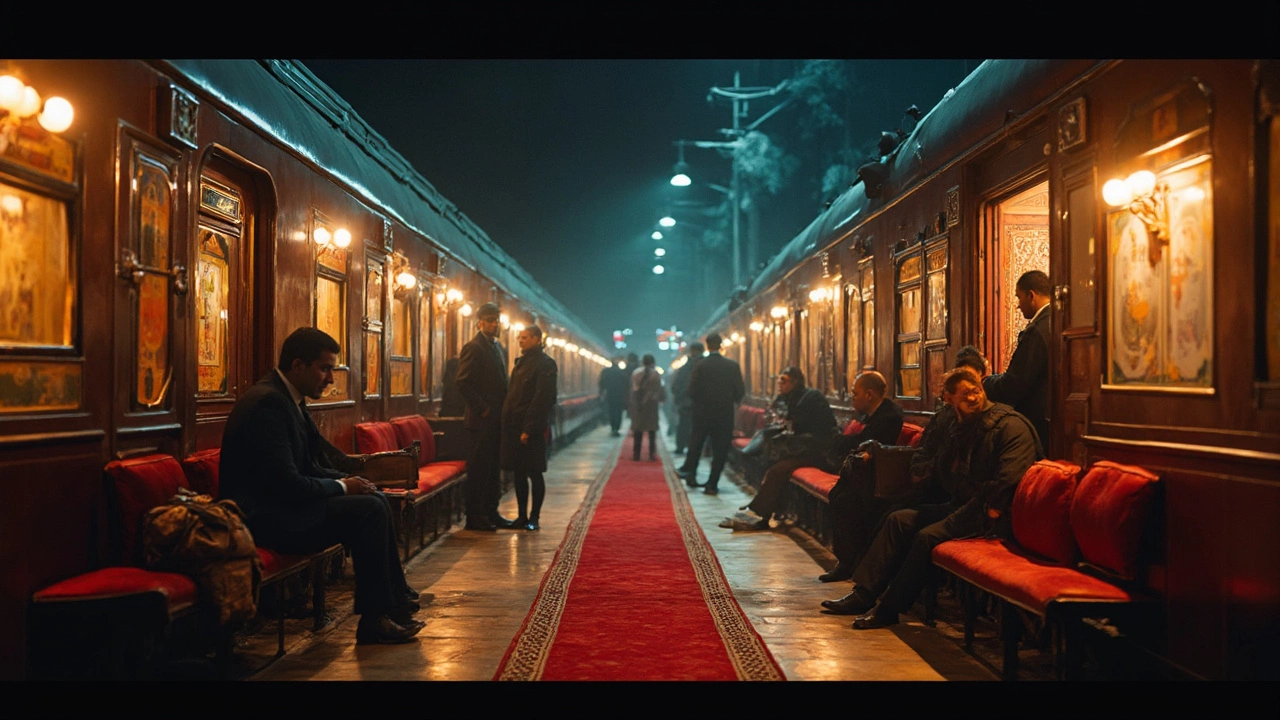Sleeper Trains: Why Are Luxury Rides So Pricey?
 May, 29 2025
May, 29 2025
Ever checked sleeper train prices and thought, 'Is this a joke?' You're not alone. People are shocked by the cost of a bed on wheels—sometimes it rivals nice hotels or business-class flights. So what exactly pushes sleeper train tickets into luxury territory?
The real kicker is that you’re not just paying for a bed. There’s the personal cabin, the over-the-top service, and little perks like private bathrooms, cooked meals, or your own butler if you go all out. Some routes throw in wine tastings or fresh flowers every night. Sure, you could just grab a seat for much less, but you’d miss all the bells and whistles that transform a simple journey into a rolling hotel.
- What Sleeper Trains Actually Offer
- Behind-the-Scenes Costs
- Demand and Limited Space
- Are Luxury Sleeper Trains Worth It?
- Tips for Booking Smarter
What Sleeper Trains Actually Offer
Sleeper trains aren’t just about a moving bed—they pack in a bunch of stuff that you won't find on a basic train ride. Let’s break down what you actually get when you shell out for that ticket.
- Private cabins: Ranging from compact single rooms to suites that look like mini hotel rooms. Some offer double beds, fancy decor, and even private showers—think Venice Simplon-Orient-Express.
- Full-service dining: Meals are often included, and not just any food. We’re talking three-course dinners, local specialties, and real cutlery. No sad microwave sandwiches here.
- Personal service: Staff make your bed, bring drinks, and help with bags. On high-end routes, you even get a dedicated attendant or butler.
- Clean bathrooms: Most cabins have shared or private bathrooms. In luxury classes, you’ll find en-suite showers and designer touches.
- Extras: Depending on the train, you might get free Wi-Fi, slippers, welcome drinks, or even onboard entertainment. Some trains offer off-train excursions as part of the package.
Take a look at how a typical luxury sleeper train stacks up:
| Feature | Standard Overnight Train | Luxury Sleeper Train |
|---|---|---|
| Cabin Type | Basic bunk or seat | Private suite with bed |
| Meals Included | No or simple snacks | Full-course dining |
| Bathroom Access | Shared | Private in some cabins |
| Staff Service | Minimal | Dedicated attendant |
| Extras | None or limited | Events, excursions, perks |
Some sleeper trains, like Japan’s Seven Stars or South Africa’s Blue Train, go all-out with design, gourmet chefs, and huge windows for taking in the view. The sleeper trains on these routes have a reputation for real comfort—something you just won’t find on a regular night train or in a cramped airplane seat.
Behind-the-Scenes Costs
The price tag on a sleeper train ticket isn’t just about covering a mattress and linens. These trains work way differently than your standard rail service. The costs pack a punch because every night you’re rolling between cities, there’s a massive effort happening behind the scenes. Break it down, and every item on the bill starts to make sense.
First, sleeper carriages are a pain to maintain compared to regular trains. Each cabin needs cleaning like a hotel room—with fresh sheets, spotless bathrooms, and mini toiletries. On luxury sleeper trains, some cleaning staff even turn down your bed at night. Upkeep goes beyond just hygiene: everything from the plumbing to the fancy interior decorations and climate control needs constant attention, which means bigger bills and more crew members.
Then there’s staff. On a regular train, the crew-to-passenger ratio is pretty low. On these sleepers, it’s the other way around. There are hosts pouring your coffee in the morning, chefs whipping up gourmet meals, and porters on call 24/7. More hands on deck mean more wages to pay—plus training, uniforms, and room for staff to rest, all factored into your ticket price.
Another thing most people don’t think about: these trains often pay higher track access fees to run overnight or cross borders. They usually travel special scenic or longer routes, not always the fastest ones, which increases access costs and scheduling complications.
Check out some average costs per journey:
| Cost Type | Estimated Cost per Journey (USD) |
|---|---|
| Cabin Cleaning/Maintenance | $200 - $500 |
| Onboard Staff Wages | $1,000 - $2,500 |
| Premium Meals & Supplies | $300 - $700 |
| Track Access/Route Fees | $1,500 - $3,500 |
So, when you see the high fares, remember—most of your money goes to real stuff, not just flashy branding. The costs pile up because sleeper trains offer a rolling, high-maintenance hotel, not just basic transportation.

Demand and Limited Space
This is where things get really interesting—there just aren’t many sleeper cabins available on most trains. Even the fanciest sleeper trains, like Venice Simplon-Orient-Express or Japan’s Seven Stars, have super limited space. We're talking sometimes less than 20 cabins per train. And it’s not just a problem for those famous lines—most overnight trains across Europe or Asia can’t carry that many people because cabins are big and take up a lot of room.
This drives demand way up. People plan these trips months or even a year ahead. Trains like the Caledonian Sleeper from London to Scotland can sell out popular dates weeks in advance, especially in the summer. When you mix high demand with so few spots, prices just keep climbing.
Here’s a look at how cabin space compares to regular seating on popular routes:
| Train Route | Sleeper Cabins Per Train | Standard Seats Per Train |
|---|---|---|
| Venice Simplon-Orient-Express | 17 | - |
| Caledonian Sleeper (London-Edinburgh) | 40 | 190 |
| Nightjet Vienna-Berlin | 32 | 400 |
This means sleeper cabins sell out fast, and companies can charge a premium since not everyone will fit. Think about it: a regular seat train can pack in way more people, but sleeper trains are all about space and privacy, so there’s a natural limit to how many tickets they can sell per night. If you want to ride, booking early isn’t just a tip—it’s a must.
Are Luxury Sleeper Trains Worth It?
The real question is, will splurging on a sleeper train actually leave you grinning or just broke? It boils down to what you expect from the trip. If your idea of travel is just getting from point A to B, most sleeper train tickets won't make sense. But if you want the travel itself to be the highlight—a dinner in a fancy dining car, your own cabin, waking up to wild landscapes—then there’s value here that’s hard to duplicate elsewhere.
Luxury sleeper trains are all about the full-on experience. You’re paying not only for a bed, but for top-level hospitality, exclusive access to historic or scenic routes, and often some truly unique extras. For example, the Venice Simplon-Orient-Express includes multi-course meals from Michelin-starred chefs, while South Africa’s Rovos Rail actually makes stopovers for safari tours. These aren’t your average commutes—they’re rolling five-star hotels.
What about price? Let’s get concrete. Here’s a comparison of well-known luxury sleeper trains and what a single night might set you back:
| Train Name | Approx. Cost Per Night (USD) | Main Perks |
|---|---|---|
| Venice Simplon-Orient-Express (Europe) | $1,200-$3,000 | Private cabins, gourmet meals, vintage luxury |
| Rovos Rail (South Africa) | $1,200-$2,000 | Suites, all-inclusive, off-train excursions |
| Belmond Royal Scotsman (UK) | $2,500-$5,500 | Country house vibe, off-train activities, spa car |
| Palace on Wheels (India) | $650-$1,800 | Spacious cabins, included city tours, all meals |
For most people, these prices put luxury sleeper trains firmly in the "bucket list" category. It’s a big investment, and not everyone sees the payoff. If you’re someone who geeks out about train history, loves slow travel, or just wants an excuse to unplug and be pampered, the cost starts making sense. The folks who rave about these trips often say the combination of scenery, food, ease, and adventure was worth every cent. On the other hand, if you’d rather spend that cash on a week-long beach resort—or can’t imagine enjoying an all-night train ride—these journeys probably aren’t for you.
- If you’re tempted, look for off-season deals, last-minute singles, or cabin sharing with a friend. Some lines offer bundled excursions, so you get more bang for your buck.
- Read real reviews and watch YouTube walkthroughs before booking. The hype can sometimes outshine the reality.
- If luxury is out of your league, try mid-range sleeper services in Europe or Asia—they’re a huge jump up from regular seats but way cheaper than the ultra-luxe options.
Bottom line: Worth it if the journey itself is your main event. Not worth it if you’re just after a good night’s sleep and quick transit.

Tips for Booking Smarter
Ready to hop on a sleeper train but don’t want your wallet to cry? Good news: there are ways to cut the cost and squeeze more value from your ride. Here’s how you can score those posh beds without burning through your travel fund.
- Book Early: Most companies open bookings 3-6 months in advance. The cheapest sleeper train cabins vanish first—especially on popular routes like the Paris-Venice Thello or India’s Maharajas’ Express. Plan as soon as you know your dates.
- Stay Flexible: Prices shift based on demand. Traveling mid-week, outside peak holiday seasons, or booking last-minute “unsold” cabins can save you a serious chunk of change.
- Compare Routes and Classes: Not all luxury sleeper trains are created equal. Compare lines like the Venice Simplon-Orient-Express, Spain’s El Transcantábrico, or Japan’s Seven Stars in Kyushu. Some standard sleeper trains in Europe give you a taste of luxury at half the price of the ultra-high-end ones.
- Use Rail Passes: If you’re stringing together multiple train journeys, a pass like Eurail or Japan Rail Pass might include discounted or bundled sleeper ticket options. Always check what’s covered before splurging.
- Follow the Deals: Sign up for train operator newsletters and alerts. Major companies (like Belmond for the Orient Express) sometimes drop flash sales—think 20–30% off, or free upgrades near departure dates.
To give you an idea of what to expect by season and route, check this out:
| Route | Typical Price (per person) | Book Early Discount | Peak Season Price |
|---|---|---|---|
| Venice Simplon-Orient-Express (London–Venice) | $3,000–$4,000 | Up to 20% off | Up to $6,000 |
| Maharajas’ Express (Delhi–Mumbai) | $3,500–$5,500 | Up to 15% off | $5,900+ |
| Nightjet (Vienna–Paris, Standard Sleeper) | $120–$250 | Up to 25% off | $300+ |
The main thing? Don’t treat booking a sleeper train like you would a regular flight or economy seat. Prices move fast, perks go quickly, and if you know the tricks, you’ll get a much better deal. Keep your eyes open for those rare bargains—they’re out there if you’re persistent.